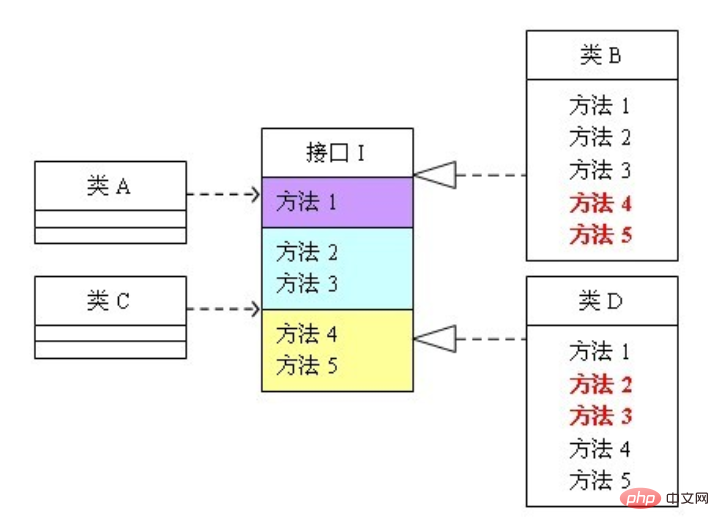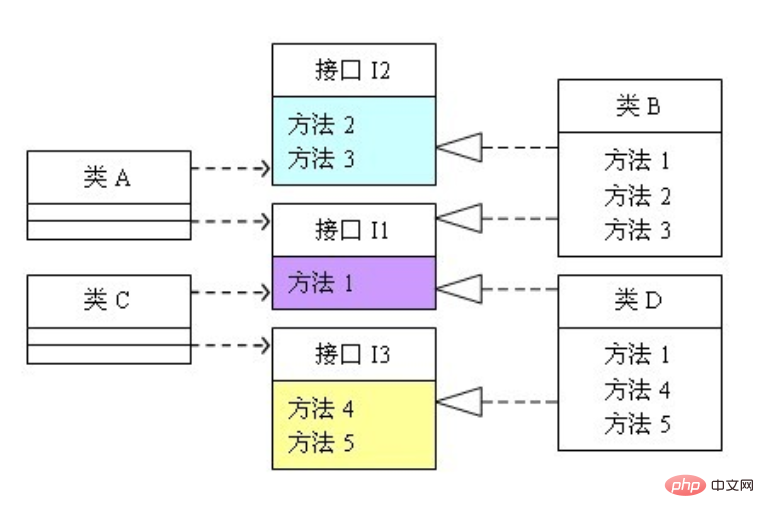What is the interface isolation principle?
The client should not rely on interfaces it does not need; the dependence of one class on another class should be based on the smallest interface.
It is better to use multiple specialized interfaces than a single general interface.
The dependence of one class on another class should be based on the smallest interface.
An interface represents a role, and different roles should not be assigned to one interface. Interfaces that are not related are merged together to form a large and bloated interface, which is a pollution to roles and interfaces.
"Clients should not be forced to rely on methods they do not use. The interface belongs to the client, not the class hierarchy in which it is located." This is very clear. To put it more generally, do not force clients to use methods they do not use. methods, if users are forced to use methods they do not use, then these customers will face changes caused by changes in these methods they do not use.

What this picture means is: Class A depends on method 1, method 2, and method 3 in interface I, and class B is the implementation of class A's dependence. Class C depends on method 1, method 4, and method 5 in interface I. Class D is the implementation of dependence on class C. For classes B and D, although they both have unused methods (that is, the methods marked in red font in the figure), since interface I is implemented, these unused methods must also be implemented. It can be seen that if the interface is too bloated, as long as the methods appear in the interface, regardless of whether they are useful to the classes that depend on it, these methods must be implemented in the implementation class. This is obviously not a good design. If this design is modified to comply with the interface isolation principle, interface I must be split. Here we split the original interface I into three interfaces. The split design is as shown in the figure

The meaning of the interface isolation principle is: establish a single interface , do not build a huge and bloated interface, try to refine the interface, and try to have as few methods in the interface as possible. In other words, we need to establish dedicated interfaces for each class, rather than trying to build a huge interface for all classes that rely on it to call. In the example in this article, the interface isolation principle is used to change a huge interface into three dedicated interfaces. In programming, it is more flexible to rely on several dedicated interfaces than to rely on one comprehensive interface. Interfaces are "contracts" set externally during design. By decentrally defining multiple interfaces, we can prevent the spread of external changes and improve the flexibility and maintainability of the system.
Speaking of this, many people will think that the interface isolation principle is very similar to the previous single responsibility principle, but it is not. First, the single responsibility principle originally focused on responsibilities; while the interface isolation principle focused on the isolation of interface dependencies. Secondly, the single responsibility principle mainly constrains classes, followed by interfaces and methods, and it targets the implementation and details of the program; while the interface isolation principle mainly constrains interfaces, mainly for abstraction, and for the construction of the overall framework of the program.
When using the interface isolation principle to constrain interfaces, pay attention to the following points:
The interface should be as small as possible, but within limits. It is a fact that refining the interface can improve programming flexibility, but if it is too small, it will cause too many interfaces and complicate the design. So it must be done in moderation.
Customize services for classes that rely on interfaces, exposing only the methods it needs to the calling class, and hiding the methods it doesn't need. Only by focusing on providing customized services for a module can minimal dependencies be established.
Improve cohesion and reduce external interaction. Make the interface use the fewest methods to accomplish the most things.
The principle of interface isolation must be used in moderation. It is not good to design the interface too large or too small. When designing interfaces, only by spending more time thinking and planning can you accurately implement this principle.
The above is the detailed content of What is the interface isolation principle?. For more information, please follow other related articles on the PHP Chinese website!

Hot AI Tools

Undresser.AI Undress
AI-powered app for creating realistic nude photos

AI Clothes Remover
Online AI tool for removing clothes from photos.

Undress AI Tool
Undress images for free

Clothoff.io
AI clothes remover

Video Face Swap
Swap faces in any video effortlessly with our completely free AI face swap tool!

Hot Article

Hot Tools

Notepad++7.3.1
Easy-to-use and free code editor

SublimeText3 Chinese version
Chinese version, very easy to use

Zend Studio 13.0.1
Powerful PHP integrated development environment

Dreamweaver CS6
Visual web development tools

SublimeText3 Mac version
God-level code editing software (SublimeText3)

Hot Topics
 1660
1660
 14
14
 1416
1416
 52
52
 1310
1310
 25
25
 1260
1260
 29
29
 1233
1233
 24
24
 How does session hijacking work and how can you mitigate it in PHP?
Apr 06, 2025 am 12:02 AM
How does session hijacking work and how can you mitigate it in PHP?
Apr 06, 2025 am 12:02 AM
Session hijacking can be achieved through the following steps: 1. Obtain the session ID, 2. Use the session ID, 3. Keep the session active. The methods to prevent session hijacking in PHP include: 1. Use the session_regenerate_id() function to regenerate the session ID, 2. Store session data through the database, 3. Ensure that all session data is transmitted through HTTPS.
 Explain different error types in PHP (Notice, Warning, Fatal Error, Parse Error).
Apr 08, 2025 am 12:03 AM
Explain different error types in PHP (Notice, Warning, Fatal Error, Parse Error).
Apr 08, 2025 am 12:03 AM
There are four main error types in PHP: 1.Notice: the slightest, will not interrupt the program, such as accessing undefined variables; 2. Warning: serious than Notice, will not terminate the program, such as containing no files; 3. FatalError: the most serious, will terminate the program, such as calling no function; 4. ParseError: syntax error, will prevent the program from being executed, such as forgetting to add the end tag.
 PHP and Python: Comparing Two Popular Programming Languages
Apr 14, 2025 am 12:13 AM
PHP and Python: Comparing Two Popular Programming Languages
Apr 14, 2025 am 12:13 AM
PHP and Python each have their own advantages, and choose according to project requirements. 1.PHP is suitable for web development, especially for rapid development and maintenance of websites. 2. Python is suitable for data science, machine learning and artificial intelligence, with concise syntax and suitable for beginners.
 What are HTTP request methods (GET, POST, PUT, DELETE, etc.) and when should each be used?
Apr 09, 2025 am 12:09 AM
What are HTTP request methods (GET, POST, PUT, DELETE, etc.) and when should each be used?
Apr 09, 2025 am 12:09 AM
HTTP request methods include GET, POST, PUT and DELETE, which are used to obtain, submit, update and delete resources respectively. 1. The GET method is used to obtain resources and is suitable for read operations. 2. The POST method is used to submit data and is often used to create new resources. 3. The PUT method is used to update resources and is suitable for complete updates. 4. The DELETE method is used to delete resources and is suitable for deletion operations.
 Explain secure password hashing in PHP (e.g., password_hash, password_verify). Why not use MD5 or SHA1?
Apr 17, 2025 am 12:06 AM
Explain secure password hashing in PHP (e.g., password_hash, password_verify). Why not use MD5 or SHA1?
Apr 17, 2025 am 12:06 AM
In PHP, password_hash and password_verify functions should be used to implement secure password hashing, and MD5 or SHA1 should not be used. 1) password_hash generates a hash containing salt values to enhance security. 2) Password_verify verify password and ensure security by comparing hash values. 3) MD5 and SHA1 are vulnerable and lack salt values, and are not suitable for modern password security.
 PHP in Action: Real-World Examples and Applications
Apr 14, 2025 am 12:19 AM
PHP in Action: Real-World Examples and Applications
Apr 14, 2025 am 12:19 AM
PHP is widely used in e-commerce, content management systems and API development. 1) E-commerce: used for shopping cart function and payment processing. 2) Content management system: used for dynamic content generation and user management. 3) API development: used for RESTful API development and API security. Through performance optimization and best practices, the efficiency and maintainability of PHP applications are improved.
 Explain Arrow Functions (short closures) introduced in PHP 7.4.
Apr 06, 2025 am 12:01 AM
Explain Arrow Functions (short closures) introduced in PHP 7.4.
Apr 06, 2025 am 12:01 AM
The arrow function was introduced in PHP7.4 and is a simplified form of short closures. 1) They are defined using the => operator, omitting function and use keywords. 2) The arrow function automatically captures the current scope variable without the use keyword. 3) They are often used in callback functions and short calculations to improve code simplicity and readability.
 PHP: A Key Language for Web Development
Apr 13, 2025 am 12:08 AM
PHP: A Key Language for Web Development
Apr 13, 2025 am 12:08 AM
PHP is a scripting language widely used on the server side, especially suitable for web development. 1.PHP can embed HTML, process HTTP requests and responses, and supports a variety of databases. 2.PHP is used to generate dynamic web content, process form data, access databases, etc., with strong community support and open source resources. 3. PHP is an interpreted language, and the execution process includes lexical analysis, grammatical analysis, compilation and execution. 4.PHP can be combined with MySQL for advanced applications such as user registration systems. 5. When debugging PHP, you can use functions such as error_reporting() and var_dump(). 6. Optimize PHP code to use caching mechanisms, optimize database queries and use built-in functions. 7




